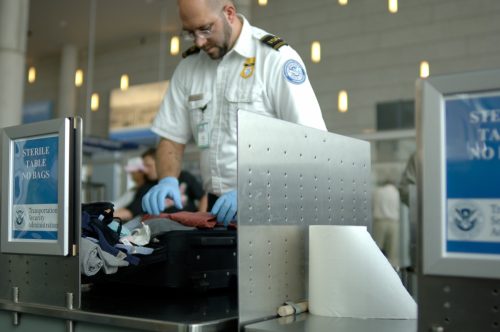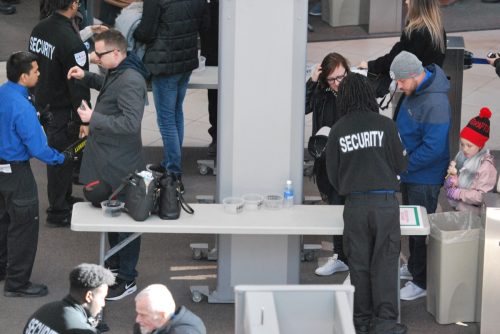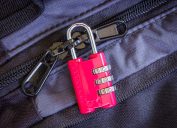What TSA Really Does With Items They Won't Let Through Security
Your belongings could end up in a few different places.

Just the mention of airport security is enough to raise your heart rate, but actually being stopped by the Transportation Security Administration (TSA)—that's a whole different level of stress. If an agent does flag you at a checkpoint, it might be because you you forgot about a half-empty water bottle in your purse or you packed your standard-sized shampoo instead of your travel-sized bottle. Violations of the 3-1-1 rule for liquids are pretty common—and often an honest mistake—but they aren't the only items that don't make it through security. But have you ever wondered what TSA does with all this contraband after the fact? The answer might be surprising. Read on to find out how the agency handles these situations.
READ THIS NEXT: 7 Clothing Items to Never Wear Through Airport Security, Experts Say.
TSA gives you a choice at the checkpoint.

TSA has a page dedicated to items that are "left behind" but lost and unclaimed property are different from prohibited items. TSA Regional Spokesperson Jessica Mayle tells Best Life that when you're stopped for a prohibited (but not illegal) item, you have a few choices as to how you want to proceed. Yes, you read that right, agents let you decide. You can opt to: A) Put it in a checked bag. B) Hand it off to someone who isn't traveling. C) Return it to your car. D) Mail it home or to your destination (if the airport has a mailing service). E) Voluntarily surrender it to TSA.
"TSA does not confiscate the items, rather the traveler makes a decision on how they want to handle the situation," Mayle explains.
The majority of these choices require you to exit the security line, which is arguably why so many of us opt to relinquish whatever got us stopped. As Mayle points out, TSA doesn't consider these items "confiscated," so, if you went with "E" and decided to give your item up, there are a few things you should know about where it's headed.
Surrendered items have different destinations.

What happens to a surrendered item depends on what it is, but don't expect to be reunited with that shampoo bottle you mistakenly put in your carry-on. "Large liquid items such as shampoo, beverages, body spray, shaving cream, cologne, hair gel, and other large liquids that are surrendered to TSA are thrown into the trash," Mayle says.
Other items are turned over to the state. "Prohibited items such as knives and large tools (there is a limit of seven inches or smaller for tools to be transported in a carry-on bag) that are surrendered are transferred to the state for the state to dispose of," Mayle says. "Many states sell the items and keep the profit. TSA makes no profit."
Illegal items like guns are an exception, as they're turned over to law enforcement. And if you're caught with one, prepare for a hefty fine and even arrest. Also, don't expect to get your firearm back from TSA. According to the agency's website, "federal law and operational consideration restrict the return" of these items.
Those items that you simply left behind and end up in the lost and found are kept by TSA for 30 days, according to the agency's website. If you don't come back to claim them, they're destroyed, turned over to the state, or sold by TSA as "excess property." If the state takes them on as surplus property, they have the option to destroy them, sell them, or donate them to charity. To retrieve a lost item, contact the lost and found department for the airport in question.
For more travel advice delivered straight to your inbox, sign up for our daily newsletter.
It's tricky to get a surrendered item back.

Prohibited items that you chose to leave behind with TSA are fairly complicated to locate. As Mike Hatten, aviation expert and retired airline pilot, told Reader's Digest, it's not necessarily easy to get something back—and in some cases, it's impossible.
Your best bet would be to check websites like USA.gov, where you can search for state surpluses, or GovDeals. On the latter site, you'll find an entire section dedicated to "Confiscated/Forfeited/Personal Property," and if you're lucky, you might just spot your long-lost pocket knife. Just be warned that often, goods are sold in bulk, so you might be on the hook for a few more pocket knives than planned.
Follow some simple steps so you never end up in a pickle.

If this whole process seems confusing, that's because it is. So, the best way you can avoid it is by being prepared. It may not seem like a big deal to chuck your toiletries, but if you've invested in a luxury lotion, that can seriously hurt your wallet!
Pay attention to the liquid requirements and make sure that you understand what's considered a liquid (anything you can spread, spill, spray, pump, or pour). You can also use TSA's nifty "What Can I Bring" tool to search for specific items and see if they're allowed in your carry-on or checked luggage.
Hatten also offers a convenient tip—keep an isolated travel bag and never put anything in it that would get you flagged at a TSA checkpoint.





















